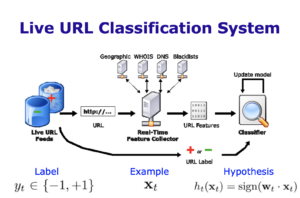
With the rise of new technology and opportunities for commerce also comes new opportunities for criminal actors. Through the use of Uniform Resource Locators (URLs), the World Wide Web is swarming with scammers marketing counterfeit goods, perpetrating financial fraud, and more. Naturally, this leads to the question: How do we know if a URL is safe to click on? Will it expose users to potential exploitation? Well, in “Identifying Suspicious URLs: An Application of Large-Scale Online Learning,” UC San Diego computer scientists explore the answers to these questions, focusing on approaches for detecting dangerous URLs.
In their paper, the team focuses on lightweight real-time classification of the URL itself to predict whether the associated site is malicious. Using lexical and host-based features of the associated URLs, they explore online learning approaches for detecting malicious Web sites. See more details below.
Press
- “Paper review: Identifying Suspicious URLs: An Application of Large-Scale Online Learning.”
- Google Tech Talk “Identifying Suspicious URLs: An Application of Large-Scale Online Learning”
Project Details
- UC San Diego Researchers: Justin Ma, Lawrence K. Saul, Stefan Savage, Geoffrey M. Voelker
- Conference: KDD09: The 15th ACM SIGKDD International Conference on Knowledge Discovery and Data Mining, Paris, France, June 2009
